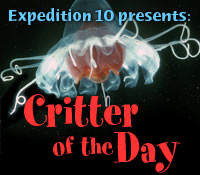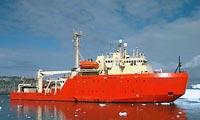|
  Today's Weather Cloudy Latitude: 63 59.02 S Longitude: 66 55.5 W Wind: 20 KT Sea State: 3 Swell Height: 3-4 Baro Pressure: 997.5 Air Temp: 1.4 Sea Surface Temp: 2.5 Vis: 10 NM    Learn more about the Gould in Deeper Discovery »
February 23, 2006 by Kate Madin The U. S. polar research vessel Laurence M. Gould is a bright orange-and-yellow ship that carries scientists to and from Antarctica and on Southern Ocean research cruises. The Gould has an ice-strengthened hull, allowing it to move through sea ice that forms seasonally near the Antarctic Peninsula. An ice-strengthened vessel is capable of continuous forward movement through 1 foot (0.3 meter) of first-year ice, while an icebreaker can travel through 3 feet (1 meter) of ice at 3 knots. The difference between the two is the amount of metal plating in the hull, with the latter having a thicker steel girdle at waterline. The Gould is 70 meters (230 feet) long, with five decks. The large hold, below the main deck, is storage space, and the top deck houses the bridge, where the captain on our trip, Scott Flanagan, chief mate Kevin LeBouef, second mate David Morse, or third mate Larry Brissette control the ship. Between the hold and the bridge lie labs, common rooms, and cabins. The ship’s broad aft (back) deck is where the scientists and marine technicians do the heavy work, launching dive boats or towing instruments. There are cranes for lifting, winches (powered spools of wire) for towing instruments, and a bay for large equipment off the aft deck. Two vans (portable metal rooms for extra space) are fastened down on deck, and the dive-gear van is in the hold. An important place on our cruise is the aquarium room, reached by going outside on the aft deck, then back into an enclosed space plumbed with running seawater. “It’s a lot like working under a waterfall,” said Pat Kremer, who with graduate student Brennan Phillips keeps live salps in containers here. On the main deck, scientists work in three large rooms—the “wet lab,” the “hydro lab’” and the “dry lab”—and smaller microscope and dark rooms. The “E-lab” is the computer center, where Electronics Technicians Kevin Pedigo and Michael Carpenter maintain the ship’s computer systems. “There are computers for the scientists, and a way to share our data on the ship’s system, which makes working together really easy,” said biologist Isabelle Williams. The Gould is home to the crew, and for a while to us, and includes home-like spaces: cabins with two bunks and a bathroom; a lounge with books and DVDs; a gym, and a sauna. On the main deck is the large mess (dining room) and galley, where chief steward Romeo Agonias and cooks Ernest Stelly and Mario Velquen make four great meals a day for the crew and scientists.
|
|||||||||||||||||||||||||||||||||||||||||||||||||||||||||||||||||||||||||||||||||||||||||||||
Mailing List | Feedback | Glossary | For Teachers | About Us | Contact
© 2010 Dive and Discover™. Dive and Discover™ is a registered trademark of Woods
Hole Oceanographic Institution

